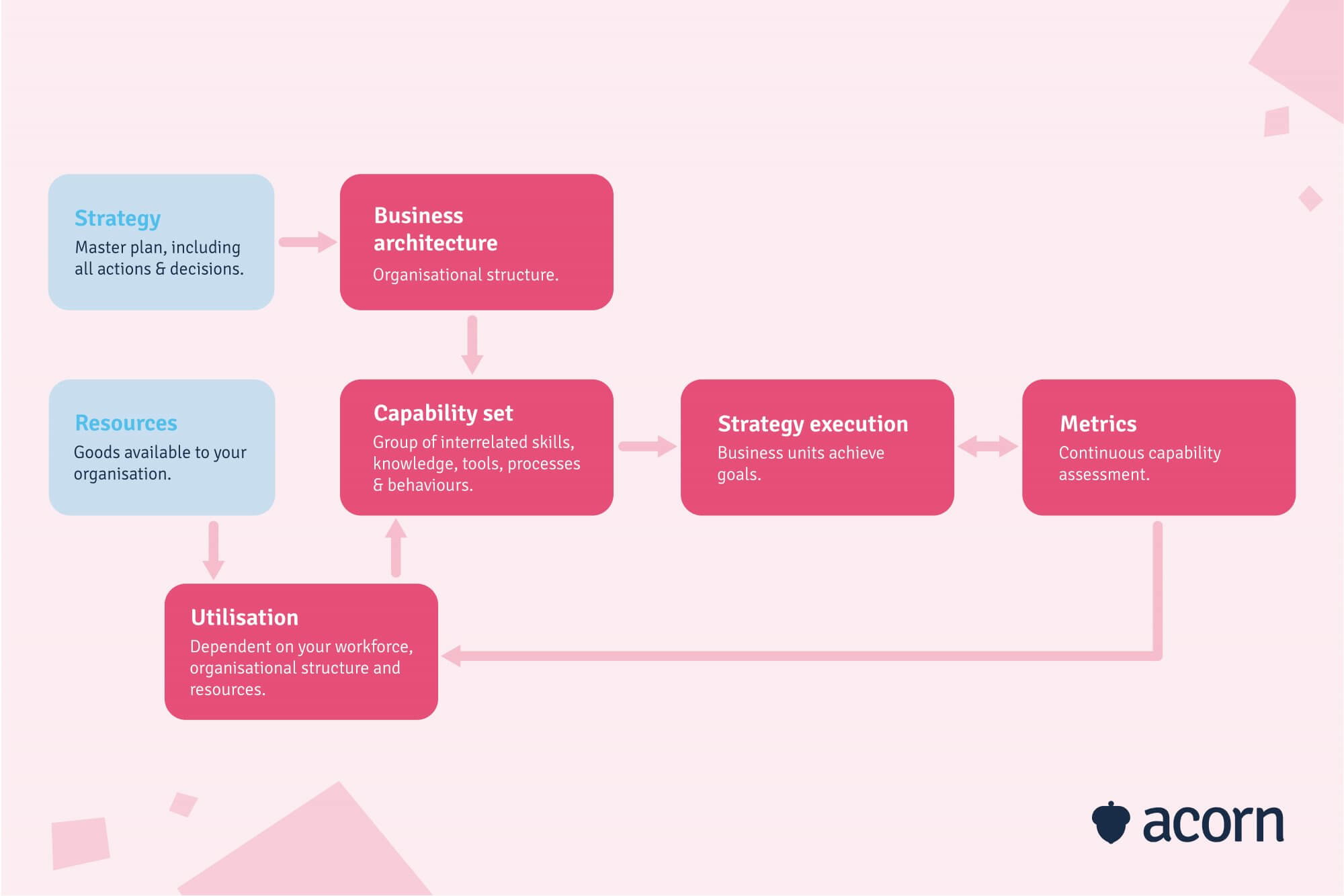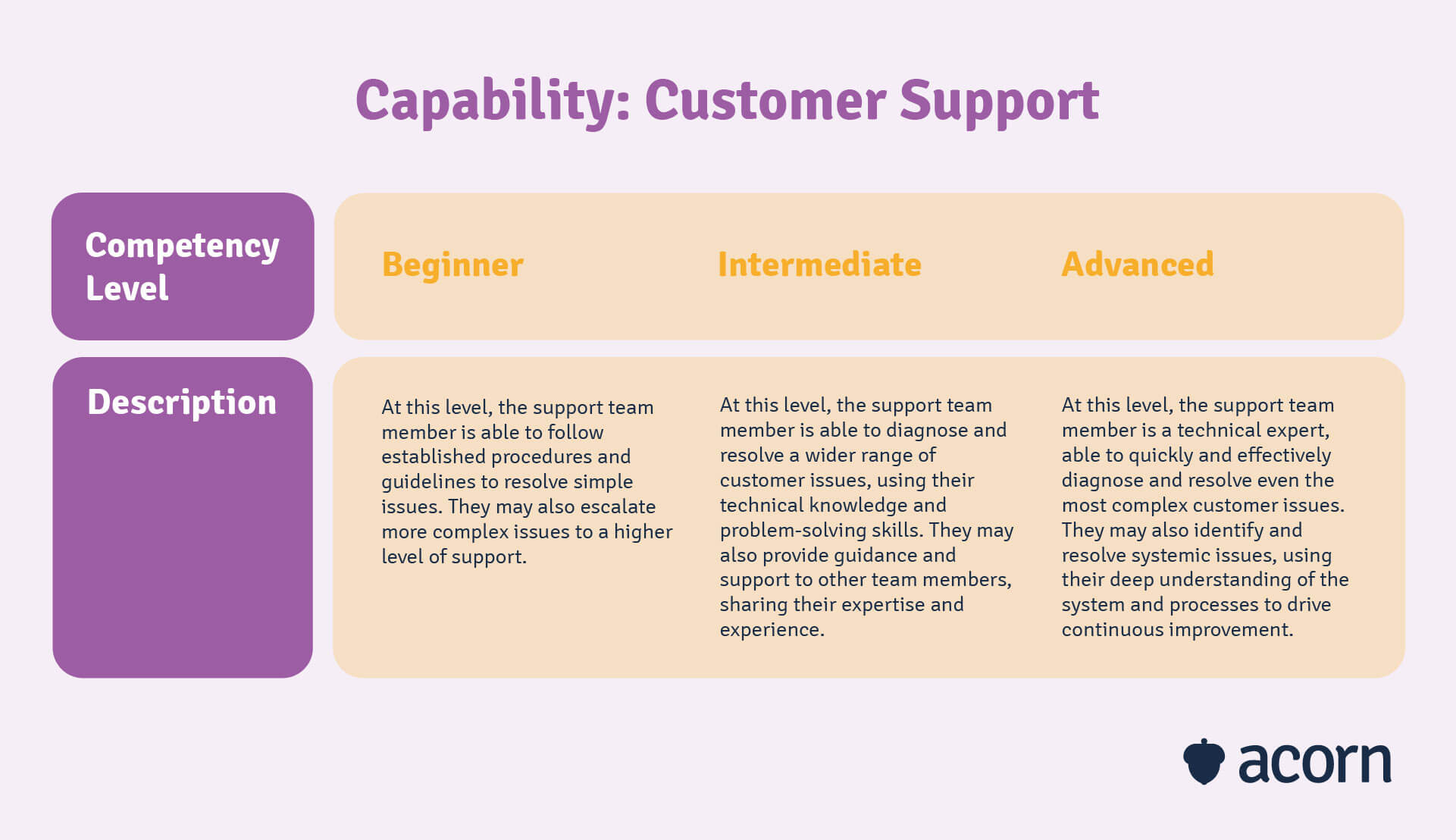Why Human Capabilities Are Crucial for Business Success
Reading Time:

Lead the pack with the latest in strategic L&D every month— straight to your inbox.
SubscribeAs a function or job-specific capability set, human capabilities help you make smarter investments for L&D, HR and org development.
They differ from other capability sets in that you can get really in the weeds with the capability needs of your people. Everything you need to know about human capabilities is in this blog. Let’s dive in.
What are human capabilities?
Human capabilities are the inherent knowledge, skills and attributes required to perform in a specific job role. They can also be used to assess and validate an employee’s potential to move into a future role.
In some cases, human capabilities can be complementary to a broader capability framework. The NSW Public Sector, as an example, has occupation-specific capability sets for a number of professional functions like human resources, finance, and legal.
How human capabilities impact business
In a nutshell, you’ll likely have two categories of capabilities in an organisation.
- Business capabilities are what an organisation can and will do to execute strategy. That’s strategic assets like tools, systems, talent and processes.
- Human capabilities essentially encapsulate what is needed in a specific function or job role.
Where human capabilities really come into play is in ensuring compliance, cohesion and efficiency in how tasks are performed within business functions (think marketing, operations, finance, etc.).
For large enterprises rich in human capital, they enable you to better pinpoint valuable capabilities at every level and uncover areas of weakness. In smaller and midsize companies, they provide a practical reason to invest in certain areas over others as you grow.
But lacking clear capabilities:
- Ideal performance may be seen as exclusive to high-potential employees, putting the strategic weight of organisational success on very few shoulders.
- KPIs for job roles may be hard to define, leading to conflicting understanding of performance and strategy.
- Functional leaders may find it difficult to translate business strategy to priorities for their units.
- Resourcing and budgeting may be ill-informed, given poor visibility on time sinks and areas of weakness or opportunities.
- Critical skills and knowledge may become obsolete without you realising, negating your ability to be agile or even build and acquire new expertise as needed.
The ability to codify, develop, assess, and operationalise capabilities is baked into our pioneering performance learning management system (PLMS). Acorn PLMS is the only solution that guides learners step by step to master the capabilities (human and business) that will propel organisational performance. The platform enables you to create contextual learning opportunites, linking learning and performance, and giving you the information to show positive business impacts.
How to define human capabilities
As with all types of capabilities, human capabilities have a few defining characteristics to look out for. Some core concepts to keep in mind are that these functional capabilities need to be accessible, valuable to both employees and organisation, and easily tracked over time.

Developable
Capabilities, by definition, are learned expertise. That means you need to consider the application for certain knowledge, tasks, processes and skills when creating capabilities.
How those capabilities can be developed really depends on your organisation’s needs; some might need ongoing development through formal training, others may be better learned on the job, and many more will be basic capabilities required to even be considered for a job role.
Individual & organisational
Consider these capabilities the bridge between what an organisation needs to do and how it does it. They should denote a skill, attribute or task that is valuable to the organisation (by way of the function it belongs to), while also describing a skill, attribute or task that an employee must possess or be able to do in a specific job role.
Quantifiable
Remember that the intangibility factor only comes into play with behavioural capabilities (given the somewhat elusive nature of behaviours and mindsets).
Any employee should be able to measure and track human capabilities themselves, whether that’s through performance indicators, learning outcomes or project outcomes. At the organisational level, you should be able to show a tangible, financial impact felt through the employee performance of a capability.
For example, under Customer Support you could have the capability “Troubleshoot and resolve customer issues”. That would be the ability to diagnose and resolve customer issues, using technical knowledge and problem-solving skills. KPIs would likely be number of tickets resolved, while performance might be evaluated on a scale of competency like below.

And what a human capability is not
Job-related capabilities, while simple in theory, do have a few rules of thumb.
- A capability is not a business function, but a business function can be a capability. That is: You’ll need a corresponding core capability for a business function in order to perform that function. However, that capability on its own does not represent the sum of all parts for said function.
- Capabilities shouldn’t be designed solely for a role. While they are indeed job-specific skills, knowledge and behaviours, they are always derived from what the organisation needs to do to execute its business strategy.
- Human capabilities aren’t separate from other capabilities in the grand strategic scheme of things. They don’t require their own capability map or framework. Generally, they’ll show a more detailed decomposition of your existing business architecture.
Measuring the business impact of human capabilities
As with any truly strategic business tool, you need to have metrics attached to human capabilities.
And as with any truly strategic metrics, you’ll want to start with organisational outcomes. Don’t be lulled into a false sense of security thinking that since capabilities are derived from business needs, it’ll be easy to measure their impact. Making the connection between capabilities at work (i.e. how they are performed by employees) and outcomes that move the dial (i.e. what business leaders want to see) can be hard at first.
To cut a long story short, you want to show positive changes over time and then translate those changes into financial terms.
From the employee side, look to:
- Performance evaluations
- Training outcomes.
And on the organisational end, go for metrics that link directly to valuable outcomes like:
- Customer satisfaction
- Process improvement
- Revenue and/or profitability
- Individual & team effectiveness
- Time to productivity.
NB: The specific metrics you choose will depend on the relevant capabilities; the particular capability of “Conceptualisation” for graphic designers may not necessarily impact customer satisfaction.
Just remember that the way to leadership’s heart is through the CEO’s priorities. This gives you the strategic context with which to measure capabilities and design the right engine for your capability building programs. It’ll also help gain buy-in from business leaders, given their KPIs will come from the CEO’s goals.
Calculating training ROI is the most common path taken. The advantage is—if training is constant and ongoing, as it should be to support a capability approach to employee development—you’ll be able to turn employee outcomes into tangible business impacts.
A training evaluation report is often most helpful, given it shows:
- Learner engagement or the quality of capability building programs, given the intent of employees to invest time in them.
- How sticky learning is based on knowledge retention.
- Insight into transfer of learning and performance improvements, through the strength of workplace support structures.
- Financial gains. That includes payback periods, time to proficiency, ROI percentage, revenue and even training costs.
The risks of not improving human capabilities
The tools employees use, the roles utilising them and the knowledge needed are changing rapidly—80% of CEOs believe it is the greatest challenge their business has.
So, the real risk of neglecting human capabilities is you may favour reactive upskilling over continuous capability building. The former is a response to performance issues already causing harm in the workplace, and the latter seeks to proactively identify and address potential gaps before they’re detrimental to business performance.
If you fall into the former scenario, it’s likely:
- Hiring cannot fill the holes poor L&D strategy leaves in the workforce.
- Reskilling is hard to argue for and deliver, given poor displays of existing capabilities and a potentially poor learning culture.
- Processes that rely on universal and standardised foundations (like performance evaluations and succession planning) will be misinformed or delayed.
- Outdated or immature capabilities will decay organisational capability as a whole.
- Getting buy-in for any capability initiative will be an uphill battle because you’ll have no past business wins to show (and if upskilling has worked, it’ll be hard to replicate without codified methods).
- Employees will be left to translate learning to everyday work, making for conflicting ways of work.
All that makes it hard for your workforce to be agile, given varying levels of competence, disjointed views of strategy and poor visibility at the organisational level of what is a strategic priority. At a more granular level, teams may be ill-formed without central human capabilities to organise themselves around. Employees may also fail to see problems or opportunities in the workday without the context through which to innovate.
Key takeaways
You can forget a lot of the jargon out there about capability theory or human development. Human capabilities aren’t even directly related to human beings. Rather, they’re a strategic business tool for economic growth, sustainable success and accelerated time to value.
And while they exist within the same framework, human capabilities differ greatly from business capabilities. That’s largely because they are generally one capability set created to define what a business function needs to do.
Exactly how that contributes to business success comes down to the measures you use for developing and assessing capability in your workforce. Human capabilities should be developable through training, quantifiable through tangible (and financial) metrics, and bridge the performance gap between employees.